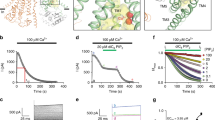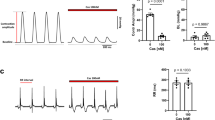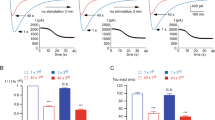Abstract
Voltage-gated calcium channels (VGCCs) conduct calcium into cells after membrane depolarization and are vital for diverse biological events1. They are regulated by various signalling pathways, which has profound functional consequences1,2. The activity of VGCCs decreases with time in whole-cell and inside-out patch-clamp recordings3. This rundown reflects persistent intrinsic modulation of VGCCs in intact cells. Although several mechanisms have been reported to contribute to rundown of L-type channels3,4,5,6, the mechanism of rundown of other types of VGCC is poorly understood. Here we show that phosphatidylinositol-4,5-bisphosphate (PtdIns(4,5)P2), an essential regulator of ion channels and transporters7,8,9,10,11,12,13,14, is crucial for maintaining the activity of P/Q- and N-type channels. Activation of membrane receptors that stimulate hydrolysis of PtdIns(4,5)P2 causes channel inhibition in oocytes and neurons. PtdIns(4,5)P2 also inhibits P/Q-type channels by altering the voltage dependence of channel activation and making the channels more difficult to open. This inhibition is alleviated by phosphorylation by protein kinase A. The dual actions of PtdIns(4,5)P2 and the crosstalk between PtdIns(4,5)P2 and protein kinase A set up a dynamic mechanism through which the activity of VGCCs can be finely tuned by various neurotransmitters, hormones and trophic factors.
This is a preview of subscription content, access via your institution
Access options
Subscribe to this journal
Receive 51 print issues and online access
$199.00 per year
only $3.90 per issue
Buy this article
- Purchase on Springer Link
- Instant access to full article PDF
Prices may be subject to local taxes which are calculated during checkout





Similar content being viewed by others
References
Hille, B. Ion Channels of Excitable Membranes (Sinauer, Sutherland, 2001)
Catterall, W. A. Structure and regulation of voltage-gated Ca2+ channels. Annu. Rev. Cell Dev. Biol. 16, 521–555 (2000)
McDonald, T. F., Pelzer, S., Trautwein, W. & Pelzer, D. J. Regulation and modulation of calcium channels in cardiac, skeletal, and smooth muscle cells. Physiol. Rev. 74, 365–507 (1994)
Chad, J. E. & Eckert, R. An enzymatic mechanism for calcium current inactivation in dialysed Helix neurons. J. Physiol. (Lond.) 378, 31–51 (1986)
Armstrong, D. & Eckert, R. Voltage-activated calcium channels that must be phosphorylated to respond to membrane depolarization. Proc. Natl Acad. Sci. USA 84, 2518–2522 (1987)
Hao, L. Y., Kameyama, A. & Kameyama, M. A cytoplasmic factor, calpastatin and ATP together reverse run-down of Ca2+ channel activity in guinea-pig heart. J. Physiol. (Lond.) 514, 687–699 (1999)
Hilgemann, D. W. & Ball, R. Regulation of cardiac Na+, Ca2+ exchange and KATP potassium channels by PIP2 . Science 273, 956–959 (1996)
Hilgemann, D. W. Cytoplasmic ATP-dependent regulation of ion transporters and channels: mechanisms and messengers. Annu. Rev. Physiol. 59, 193–220 (1997)
Hilgemann, D. W., Feng, S. & Nasuhoglu, C. The complex and intriguing lives of PIP2 with ion channels and transporters. Science STKE [online] 〈http://stke.sciencemag.org/cgi/content/full/OC_sigtrans;2001/111/re19〉 (2001).
Huang, C-L., Feng, S. & Hilgemann, D. W. Direct activation of inward rectifier potassium channels by PIP2 and its stabilization by Gβγ . Nature 391, 803–806 (1997)
Womack, K. B. et al. Do phosphatidylinositides modulate vertebrate phototransduction? J. Neurosci. 20, 2792–2799 (2000)
Kobrinsky, E., Mirshahi, T., Zhang, H., Jin, T. & Logothetis, D. E. Receptor-mediated hydrolysis of plasma membrane messenger PIP2 leads to K+-current desensitization. Nature Cell Biol. 2, 507–514 (2000)
Chuang, H-h. et al. Bradykinin and nerve growth factor release the capsaicin receptor from PtdIns(4,5)P2-mediated inhibition. Nature 411, 957–962 (2001)
Runnels, L. W., Yue, L. & Clapham, D. E. The TRPM7 channel is inactivated by PIP2 hydrolysis. Nature Cell Biol. 4, 329–336 (2002)
Fukami, K. et al. Antobody to phosphatidylinositol 4,5-bisphosphate inhibits oncogene-induced mitogenesis. Proc. Natl Acad. Sci. USA 85, 9057–9061 (1988)
Bean, B. P. Neurotransmitter inhibition of neuronal calcium currents by changes in channel voltage dependence. Nature 340, 153–156 (1989)
Liou, H-H., Zhou, S-S. & Huang, C-L. Regulation of ROMK1 channel by protein kinase A via a phosphatidylinositol 4,5-bisphosphate-dependent mechanism. Proc. Natl Acad. Sci. USA 96, 5820–5825 (1999)
Bean, B. P. Ion Channels in the Cardiovacular System; Function and Dysfunction (eds Spooner, P. M., Brown, A. M., Catterall, W. A., Kaczorowski, G. J. & Strauss, H. C.) 237–252 (Futura, New York, 1994)
Bean, B. P., Nowycky, M. C. & Tsien, R. W. β-Adrenergic modulation of calcium channels in frog ventricular heart cells. Nature 307, 371–375 (1984)
Mori, Y. et al. Primary structure and functional expression from complementary DNA of a brain calcium channel. Nature 350, 398–402 (1991)
Stephens, R. et al. Trk receptors use redundant signal transduction pathways involving SHC and PLC-γ1 to mediate NGF responses. Neuron 12, 691–705 (1994)
Choi, D.-Y., Toledo-Aral, J. J., Segal, R. & Halegoua, S. Sustained signaling by phospholipase C-γ mediates nerve growth factor-triggered gene expression. Mol. Cell. Biol. 21, 2695–2705 (2001)
Boland, L. M. & Bean, B. P. Modulation of N-type calcium channels in bullfrog sympathetic neurons by luteinizing hormone-releasing hormone: kinetics and voltage dependence. J. Neurosci. 12, 516–533 (1993)
McArdel, C. A., Franklin, J., Green, L. & Hislop, J. N. Signaling, cycling and desensitization of gonadotrophin-releasing hormone receptors. J. Endocrinol. 173, 1–11 (2002)
Rhee, S. G. Regulation of phosphoinositides-specific phospholipase C. Annu. Rev. Biochem. 70, 281–312 (2001)
McPherson, P. S. et al. A presynaptic inositol-5-phosphatase. Nature 379, 353–357 (1996)
Wenk, M. R. et al. PIP kinase Iγ is the major PI(4,5)P2 synthesizing enzyme at the synapse. Neuron 32, 79–88 (2001)
Cremona, O. & De Camilli, P. Phosphoinositides in membrane traffic at the synapse. J. Cell Sci. 114, 1041–1052 (2001)
Lu, T., Nguyen, B., Zhang, X.-M. & Yang, J. Architecture of a K+ channel inner pore revealed by stoichiometric covalent modification. Neuron 22, 571–580 (1999)
Yang, J. & Tsien, R. W. Enhancement of N- and L-type calcium channel currents by protein kinase C in frog sympathetic neurons. Neuron 10, 127–136 (1993)
Acknowledgements
We thank S. Siegelbaum for comments on the manuscript; Y. Mori for Cav2.1 cDNA; E. Perez-Reyes for β4 cDNA; T. Tanabe for α2δ cDNA; D. J. Julius for p75 and TrkA (wild-type and mutant) cDNAs. This work was supported by a grant to J.Y. from the National Heart, Lung, and Blood Institute. J.Y. is a recipient of the McKnight Scholar Award and the Scholar Research Programme of the EJLB Foundation.
Author information
Authors and Affiliations
Corresponding author
Ethics declarations
Competing interests
The authors declare that they have no competing financial interests.
Rights and permissions
About this article
Cite this article
Wu, L., Bauer, C., Zhen, Xg. et al. Dual regulation of voltage-gated calcium channels by PtdIns(4,5)P2. Nature 419, 947–952 (2002). https://doi.org/10.1038/nature01118
Received:
Accepted:
Issue Date:
DOI: https://doi.org/10.1038/nature01118
This article is cited by
-
G protein βγ subunits play a critical role in the actions of amphetamine
Translational Psychiatry (2019)
-
Structural basis of PI(4,5)P2-dependent regulation of GluA1 by phosphatidylinositol-5-phosphate 4-kinase, type II, alpha (PIP5K2A)
Pflügers Archiv - European Journal of Physiology (2014)
-
Voltage-gated Ca2+ channels in accessory lobe neurons of the chick
Journal of Comparative Physiology A (2014)
-
Mechanisms underlying the modulation of L-type Ca2+ channel by hydrogen peroxide in guinea pig ventricular myocytes
The Journal of Physiological Sciences (2013)
-
Phosphatidylinositol-4,5-bisphosphate regulates epidermal growth factor receptor activation
Pflügers Archiv - European Journal of Physiology (2011)
Comments
By submitting a comment you agree to abide by our Terms and Community Guidelines. If you find something abusive or that does not comply with our terms or guidelines please flag it as inappropriate.



